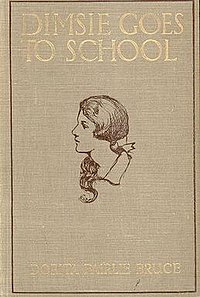| This article needs additional citations for verification. Please help improve this article by adding citations to reliable sources. Unsourced material may be challenged and removed. Find sources: "Dimsie Goes to School" – news · newspapers · books · scholar · JSTOR (March 2024) (Learn how and when to remove this message) |
 1929 Oxford University Press Hardcover Edition 1929 Oxford University Press Hardcover Edition | |
| Author | Dorita Fairlie Bruce |
|---|---|
| Illustrator | Wal Paget |
| Language | English |
| Series | Dimsie |
| Genre | Children's novel |
| Publisher | Oxford University Press |
| Publication date | 1921 |
| Publication place | United Kingdom |
| Media type | Print (Hardcover) |
| Pages | 277 pp |
| Followed by | Dimsie Moves Up |
Dimsie Goes To School is the first of the Dimsie books by author Dorita Fairlie Bruce. It was first published in 1921 under the title The Senior Prefect and changed in 1925 to Dimsie Goes To School. The book was illustrated by Wal Paget.
The protagonist of the book is ten-year-old Daphne Isabel Maitland, who is nicknamed Dimsie, on account of her initials. The book begins with Dimsie travelling in a train and about to start school at the Jane Willard Foundation, where her older cousin (also Daphne) is a prefect.
The popularity of the continuing series led to Dimsie Goes to School being reprinted several more times by the OUP, and in the 1950s by Spring Books. The illustrations kept pace with changing fashions, as the following two illustrations of the same scene demonstrate. In the 1983 edition from John Goodchild Publishers the text was "unfortunately radically modernised".


Critical reception
Dimsie Goes to School is included in The Guardian's 2009 list, "A book lover's guide to building a brilliant children's library".
References
- Löfgren, Eva Margareta (1993). Schoolmates of the Long-Ago: Motifs and Archetypes in Dorita Fairlie Bruce's Boarding School Stories. Stehag, Sweden: Symposium Graduale.
- Hunt, Peter (2004). International Companion Encyclopedia of Children's Literature. Routledge. p. 471. ISBN 0415290538. Retrieved 9 March 2024.
- Sims, Sue; Clare, Hilary (2020). The Encyclopaedia of Girls' School Stories. Vol. 1. Girls Gone By. p. 123. ISBN 9781847452573.
- Mangan, Lucy (23 January 2009). "A book lover's guide to building a brilliant children's library". The Guardian. Retrieved 7 February 2024.
This article about a children's novel of the 1920s is a stub. You can help Misplaced Pages by expanding it. See guidelines for writing about novels. Further suggestions might be found on the article's talk page. |